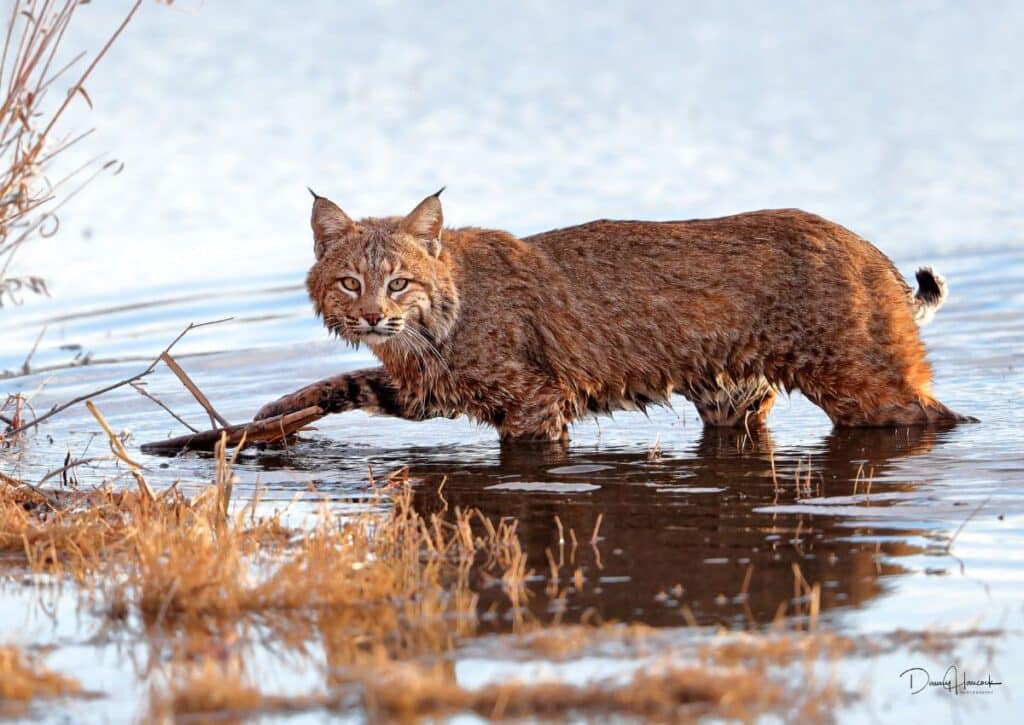Discover 15 animals in Finger Lakes National Forest on scenic hikes, trails, and fishing spots.
Ever felt like swapping your noisy neighborhood for the chirps and growls of the wild? That’s what we did in Finger Lakes National Forest, and let me tell you, the locals there have fur and aren’t shy.
This isn’t your average walk in the park. It’s a hike where you play a game of ‘I spy’ with animals hiding in the brush or splashing in a stream.
Wedged right between Seneca and Cayuga Lakes, this forest is like a live-action nature documentary, but you’re in it. We tramped through, eyes wide, looking for our next furry or feathered encounter.
Spoiler alert: we weren’t disappointed. So, come along for the ride as we dish the dirt on who we met, where we saw them, and how you can get in on the action too—whether you’re trailing a black bear or just chilling watching fish swim by on a lazy fishing day.
15 Animals in the Finger Lakes National Forest We Saw on our Hikes
Walking through Finger Lakes National Forest, we encountered various animals. Here’s a detailed account of each species we spotted during our hikes.
Beavers
The unmistakable signs of beavers were evident around the serene waters of Potomac Ponds. As we ventured closer, the rhythmic chipping sounds drew our attention to beavers crafting their dams.
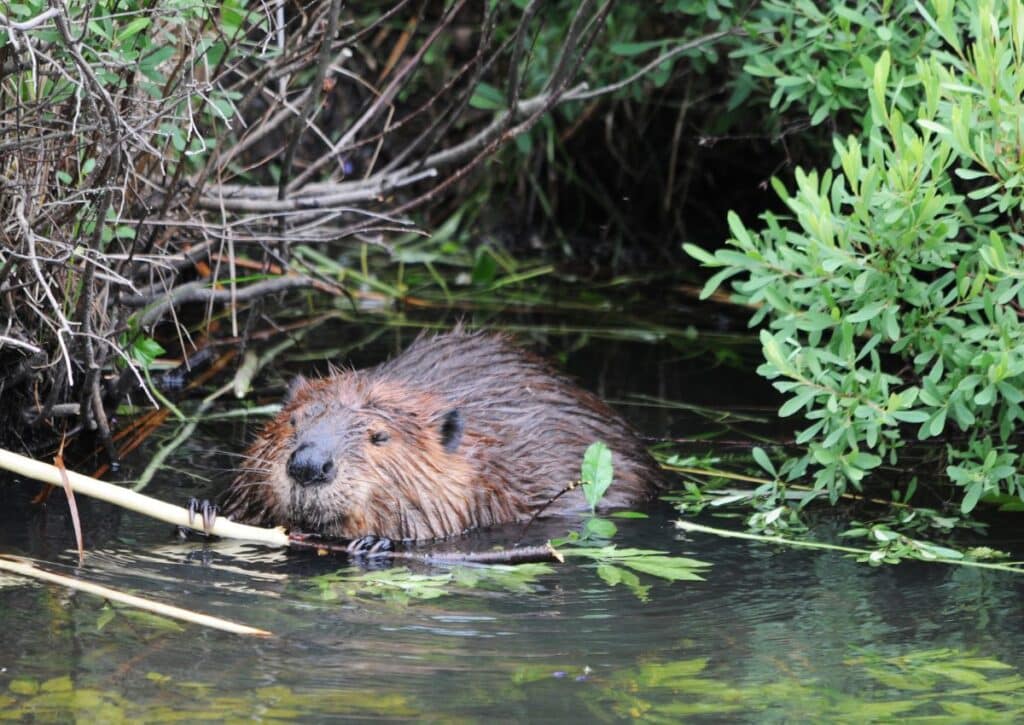
These architectural wonders, prominent in the waterways leading to Potomac Ponds, support the forest’s ecosystem by creating habitats for other animals and aiding water retention.
Bobcats
Our rare yet mesmerizing bobcat sighting occurred near the denser parts of the Interloken Trail.
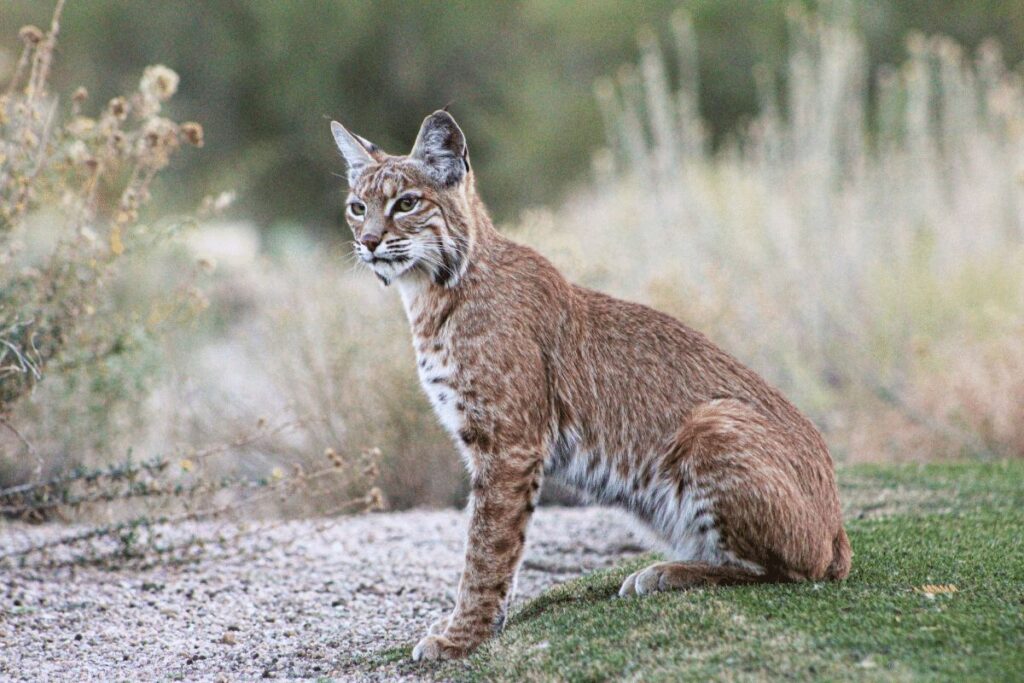
The shadowy figure of a bobcat slinking through the underbrush, its tufted ears and spotted coat visible for just a moment, served as a wild heartbeat in our forest experience.
Red Foxes
As we treaded the open areas near Burnt Hill Trail, the vibrant hue of red foxes often caught our eye.
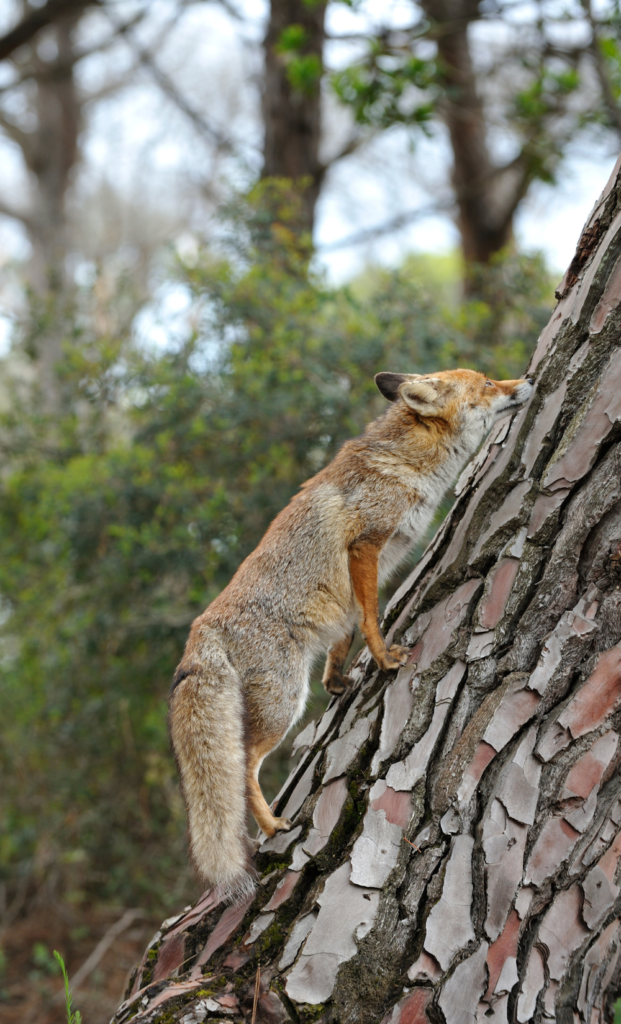
Their agile forms, darting across fields in pursuit of prey or simply playing, became a delightful spectacle.
These moments, with the foxes’ fiery coats contrasting against the forest’s verdant backdrop, showcased nature in its raw beauty.
Black Bear
In the more secluded stretches of the Finger Lakes Backbone Trail, the majestic black bear made its presence known.
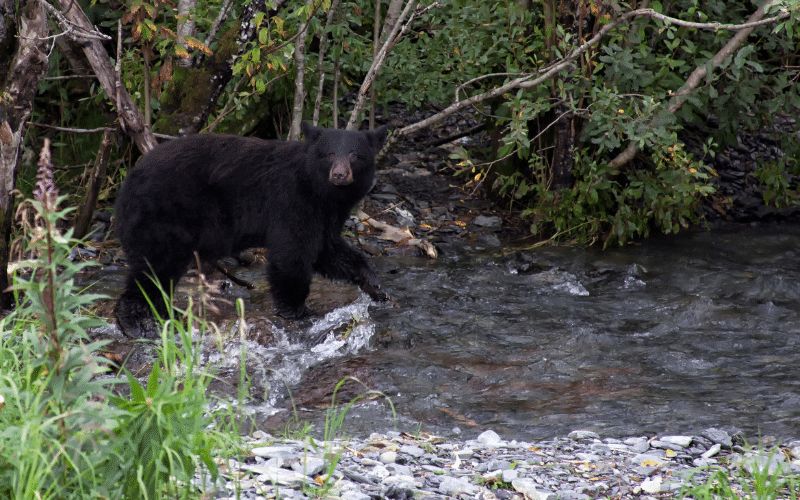
Moving with a calm yet imposing grace, these creatures are the forest’s emblem of wild power. While they mostly kept their distance, the sight of a bear rummaging for food or guiding its young added a profound sense of wonder to our hikes.
These encounters, albeit from a safe distance, were reminders of the wilderness that thrives within Finger Lakes National Forest and the importance of preserving such habitats.
White-tailed Deer
The soft rustling of leaves near Ravine Loop Trail often revealed the graceful white-tailed deer, their large eyes watchful and curious.
Grazing in meadows or leaping with an elegant agility, these deer are an emblem of the forest’s serene beauty.
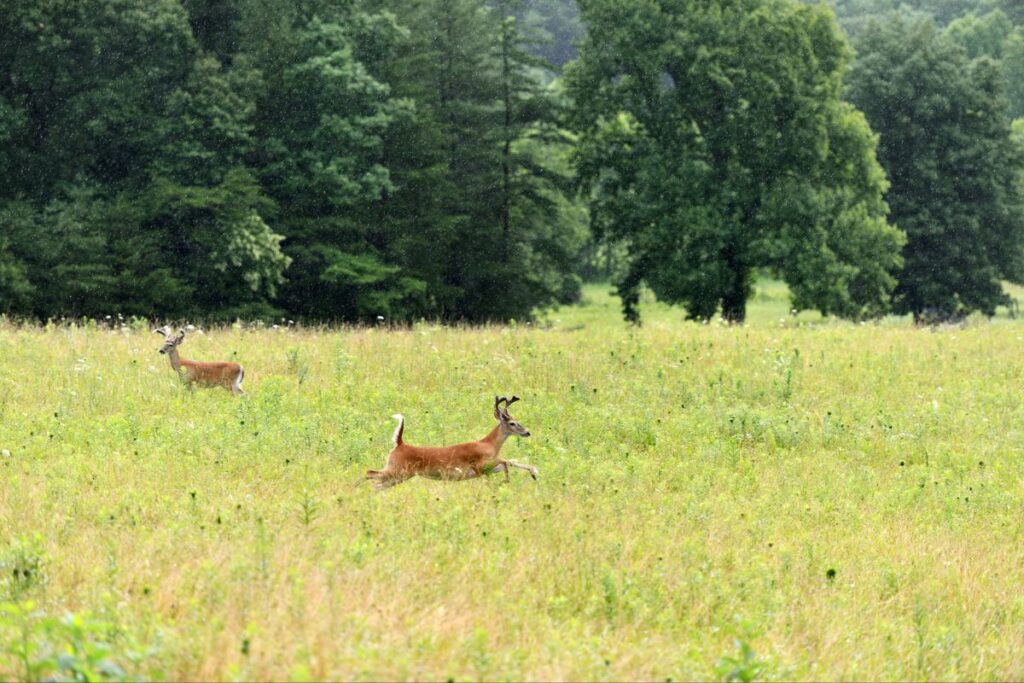
Their frequent appearances, especially during dawn and dusk, painted tranquil scenes against the backdrop of the dense woodlands of Finger Lakes National Forest.
Wood Ducks
The serene waters of Potomac Ponds became even more picturesque with the vibrant colors of wood ducks gliding smoothly across.
Their unique markings and iridescent plumage reflected beautifully in the water, creating mesmerizing ripples.
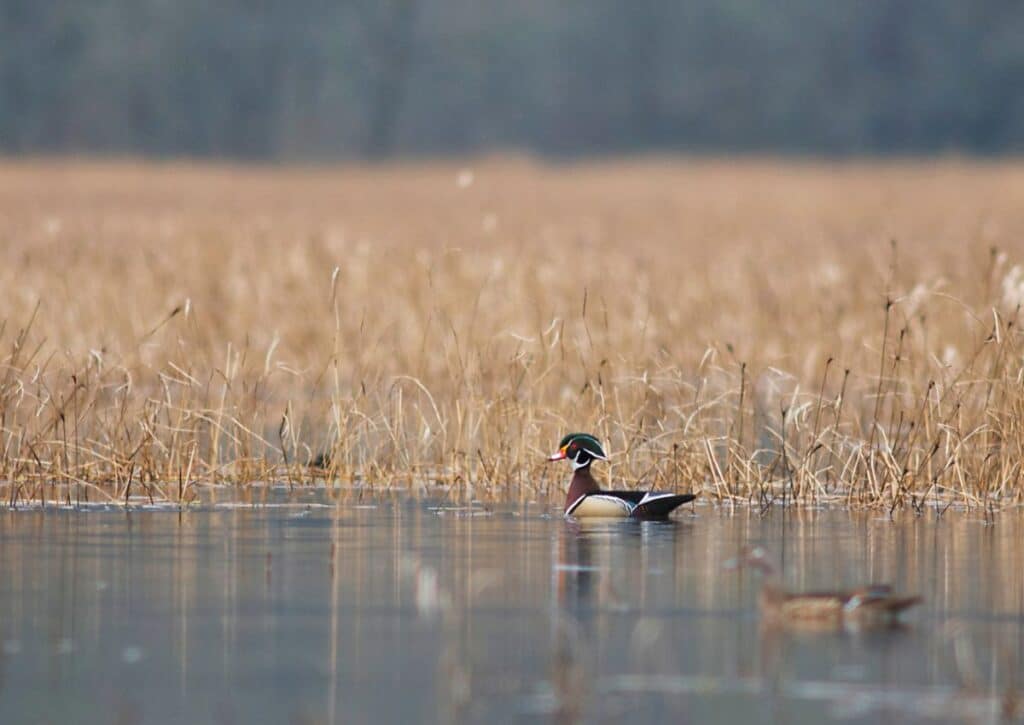
Often nestled amidst the reeds or resting by the water’s edge, these ducks added a splash of color to our aquatic encounters.
Eastern Wild Turkey
As we explored the open fields adjacent to the South Slope and Interloken Trail Loop, the unmistakable sight of eastern wild turkeys foraging caught our attention.
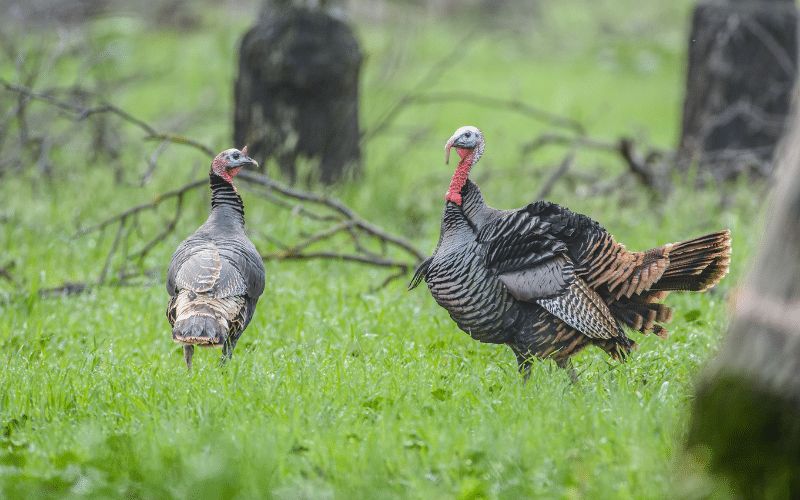
Their distinctive fan-like tails and wattled necks were a sight to behold, especially when a flock moved in unison.
Witnessing these birds in their natural habitat, strutting or foraging, was a genuine testament to the forest’s diverse avian life.
Coyotes
The haunting yet captivating howls of coyotes echoed most prominently when we ventured near the secluded parts of the No-Tan-Takto Trail.
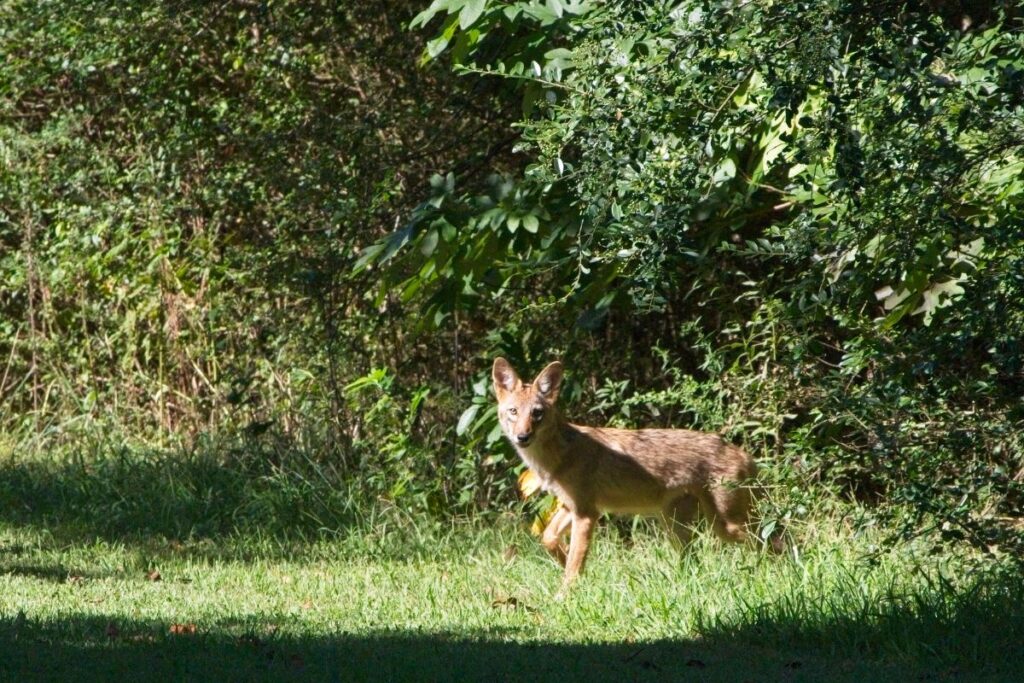
These cunning predators, with their sharp eyes and alert stance, moved with a stealthy grace.
Often spotted during twilight hours, the sight of a coyote, whether hunting in packs or traveling solo, offered a raw glimpse into the circle of life within Finger Lakes National Forest.
Minks
The wetlands adjoining the Finger Lakes Gorge Trail were where we stumbled upon the elusive minks.
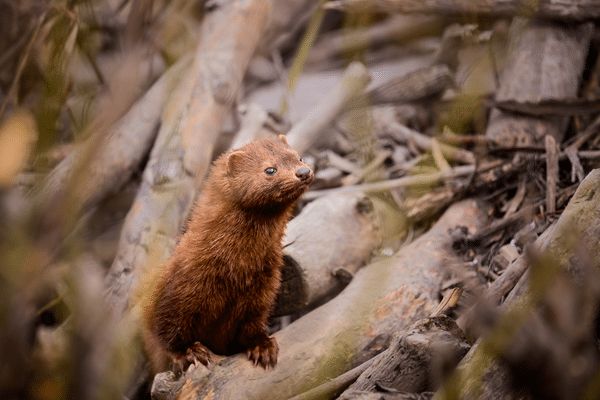
These slender creatures, with their glossy fur, could often be seen darting between rocks or swimming with a nimble finesse.
Their aquatic antics, hunting fish or playfully chasing each other, added a unique charm to our waterfront observations.
Fishers and Martens
Deep within the woodlands of the Finger Lakes Backbone Trail, the arboreal dance of both fishers and martens enthralled us.
These agile members of the mustelid family showcased their climbing prowess, moving swiftly up trees or leaping between branches.
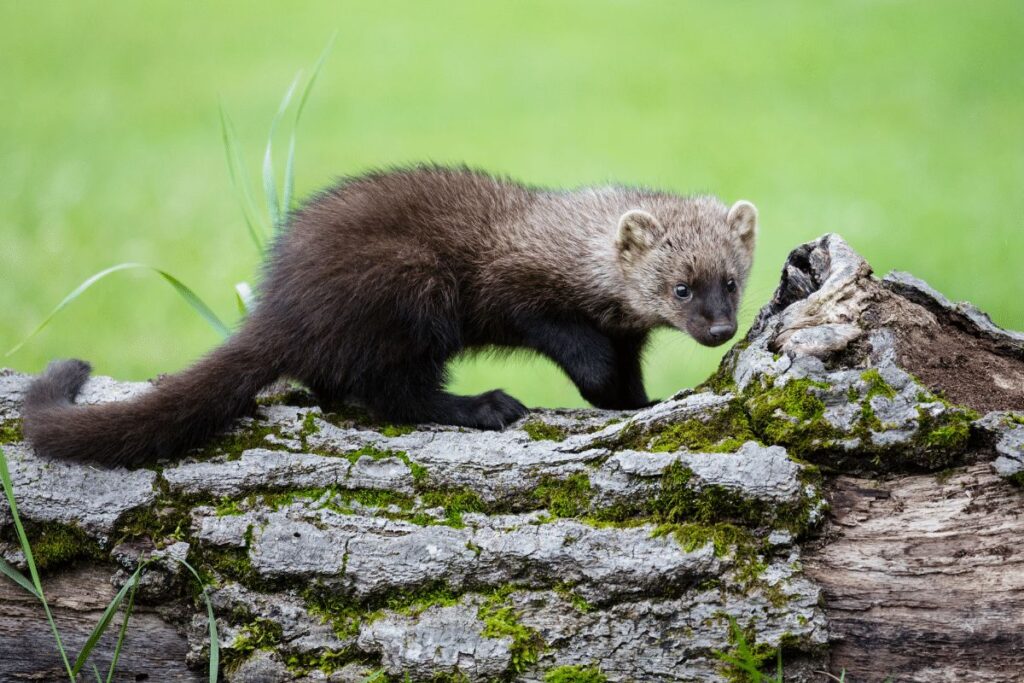
While fishers, with their larger size, primarily hunted on the ground, martens could often be seen chasing prey or frolicking high in the tree canopy.
Their presence significantly enriched our understanding of the forest’s intricate food web.
Grassland Birds
As we strolled through the expansive pastures near the South Slope and Interloken Trail Loop, the skies and grounds came alive with a symphony of grassland birds.
The rare Henslow’s sparrow with its subtle melodies and the grasshopper sparrow’s distinctive songs created a harmonious background.
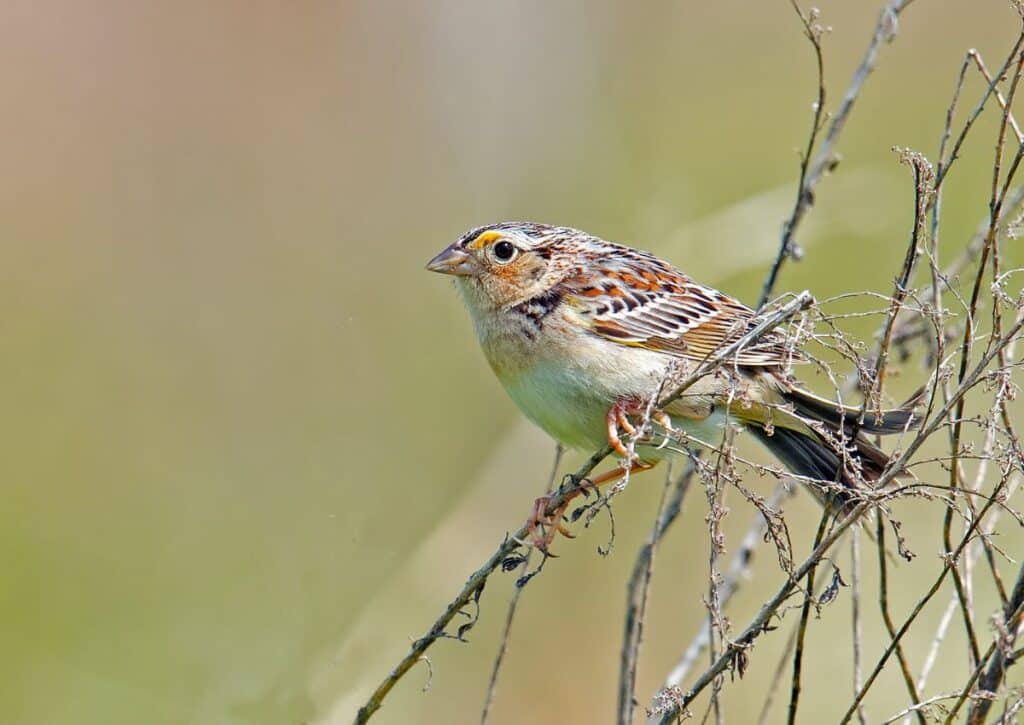
Floating gracefully above, the American kestrel showcased its aerial acrobatics.
The northern harrier’s silhouette contrasted beautifully against the sky, and the bobolinks’ vibrant colors and tunes accentuated the beauty of Finger Lakes’ grasslands.
Shrubland Birds
Treading closer to the edges of Ravine Loop Trail, the dense shrublands echoed with the calls of several unique birds.
The yellow warbler’s sweet notes intertwined seamlessly with the raspy songs of the Eastern towhee.
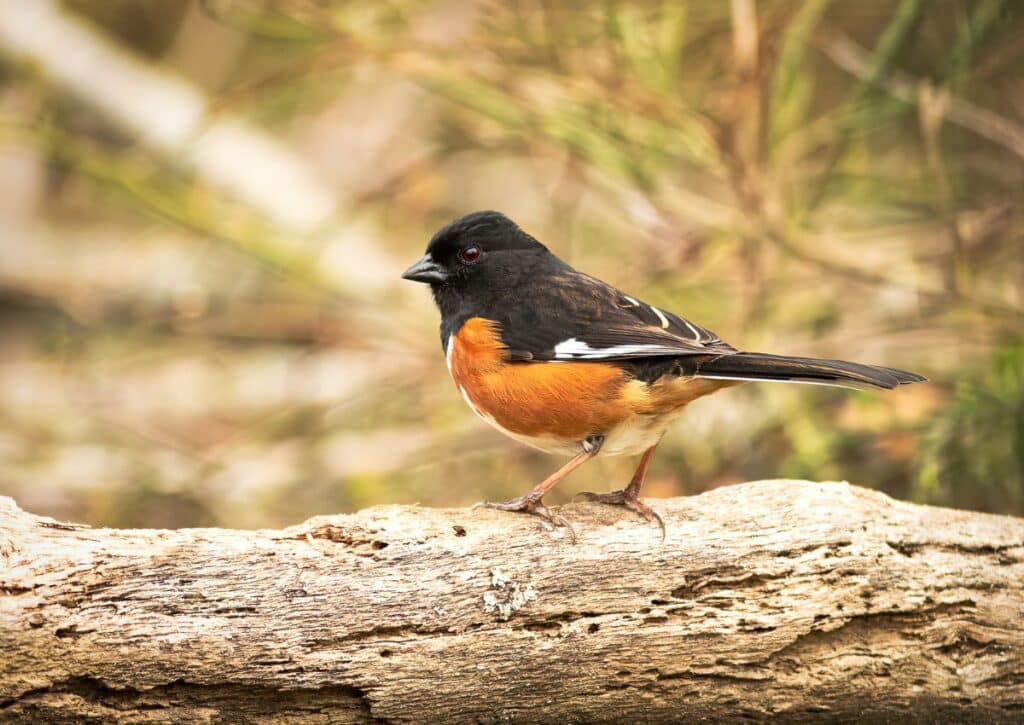
We often paused to watch the brown thrasher meticulously forage, while the yellow-billed cuckoo’s elusive presence played hide and seek with our senses.
Goldfinches, with their bright plumage, flitted around, adding dashes of gold to our shrubland adventures.
Forest Birds
The dense canopy of Finger Lakes National Forest, especially along the Finger Lakes Gorge Trail, harbored a plethora of avian wonders.
The Northern goshawk, with its fierce eyes and formidable flight, patrolled the skies. Down below, the drumming of the ruffed grouse became an unmistakable forest rhythm.
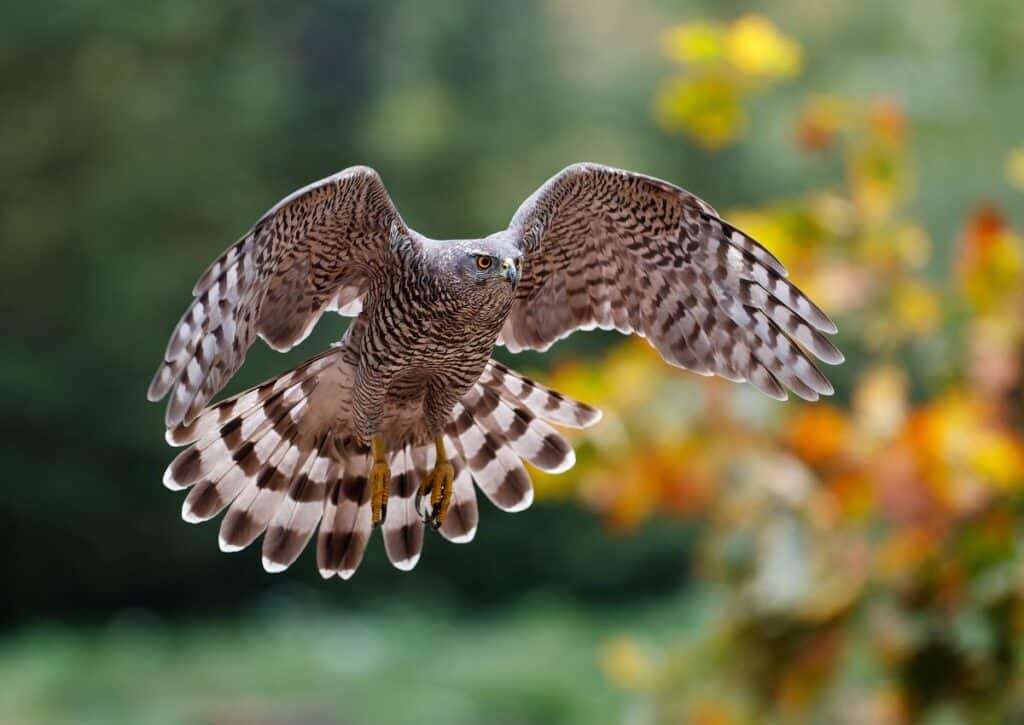
The American woodcock’s ground dance, especially during the twilight hours, was an enchanting spectacle.
And adding a splash of vibrant red amidst the green, the scarlet tanager’s appearance always signaled a special moment in our forest explorations.
Snapping Turtles
Close to the waters of Potomac Ponds, we observed the slow, deliberate movements of snapping turtles.
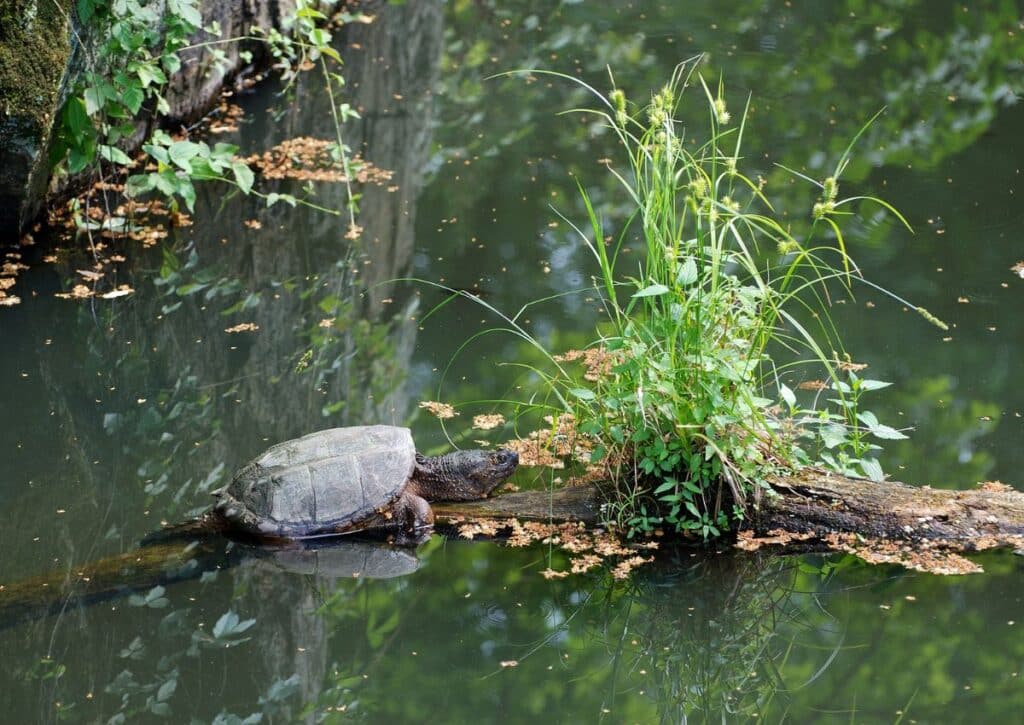
These ancient-looking creatures, with their rugged shells and powerful jaws, are a common sight near calm, freshwater areas within the Finger Lakes National Forest.
As they basked in the sun or explored the murky depths, these turtles added an age-old charm to our aquatic observations.
Raccoon
On our journey along Burnt Hill Trail, we chanced upon the playful antics of raccoons.
These masked mischief-makers are nocturnal by nature, but sometimes venture out during the day in search of food.
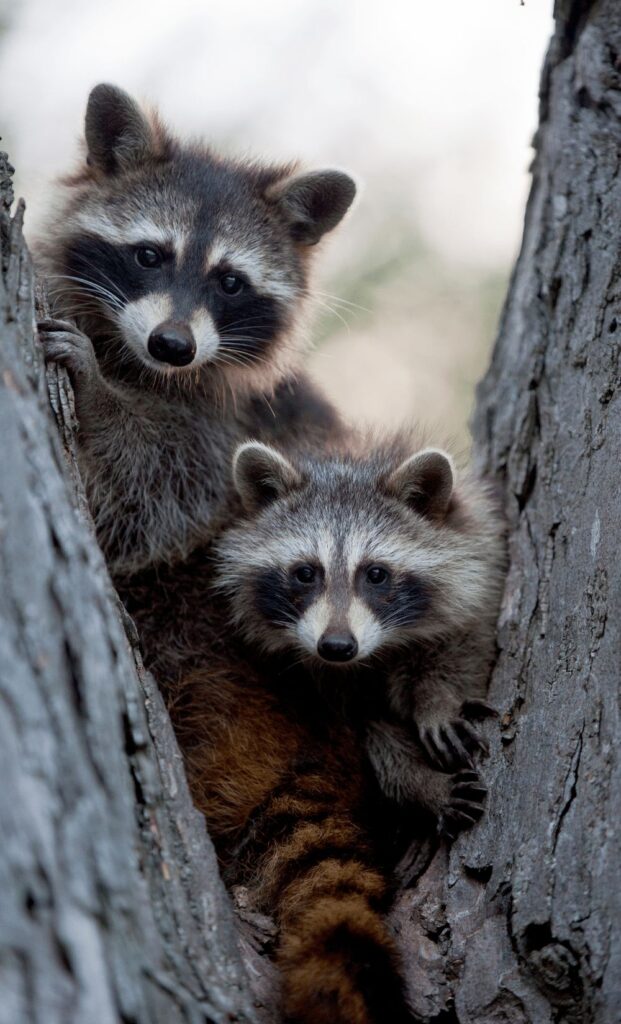
As they scoured the forest floor and tree bases, their dexterous paws and inquisitive nature provided an entertaining and genuine glimpse into the Finger Lakes’ woodland life.
Porcupines
Treading the serene paths of the Interloken Trail to Blueberry Patch Campground, we occasionally noticed the unmistakable quills of porcupines adorning tree branches.
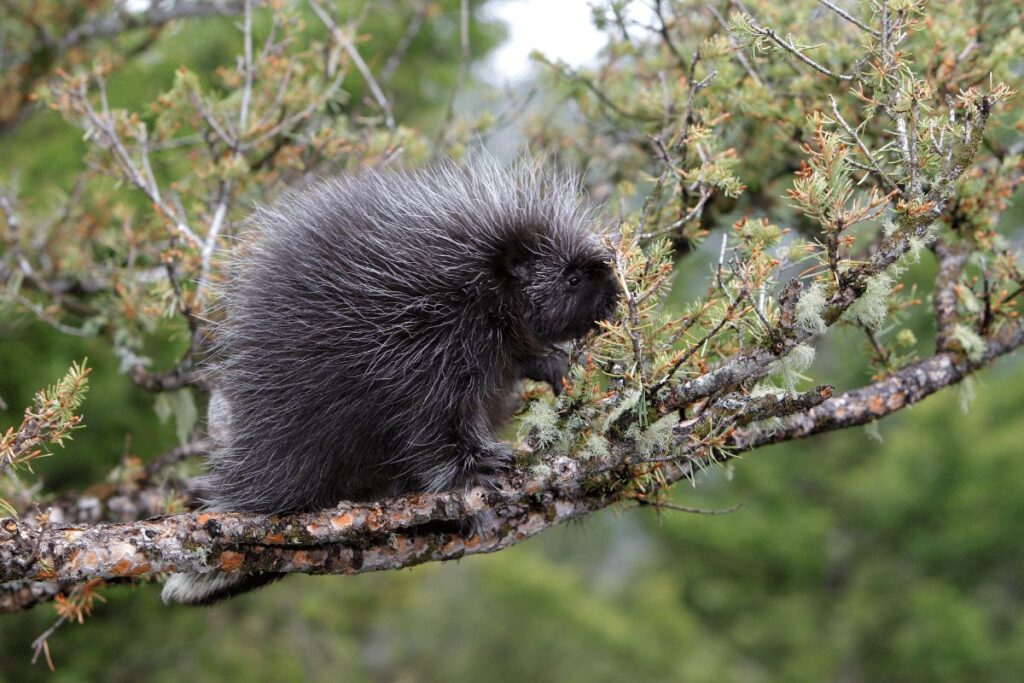
Preferring the safety of heights, these prickly mammals nibbled on tender bark and leaves.
Watching a porcupine’s careful navigation among the branches was a testament to the varied and rich wildlife experiences the Finger Lakes National Forest offers.
Fish in the Finger Lakes National Forest
The Finger Lakes National Forest, nestled between the mighty Seneca and Cayuga Lakes with the pristine waters of the river flowing alongside, offers not only terrestrial wonders but also aquatic treasures.
Here, we explore the major lakes and river enveloping the forest and their aquatic residents.
Seneca Lake
As one of the deepest of the Finger Lakes, Seneca Lake is renowned for its rich biodiversity. Its depth provides an ideal environment for lake trout, often spotted by anglers who are drawn to its vastness.
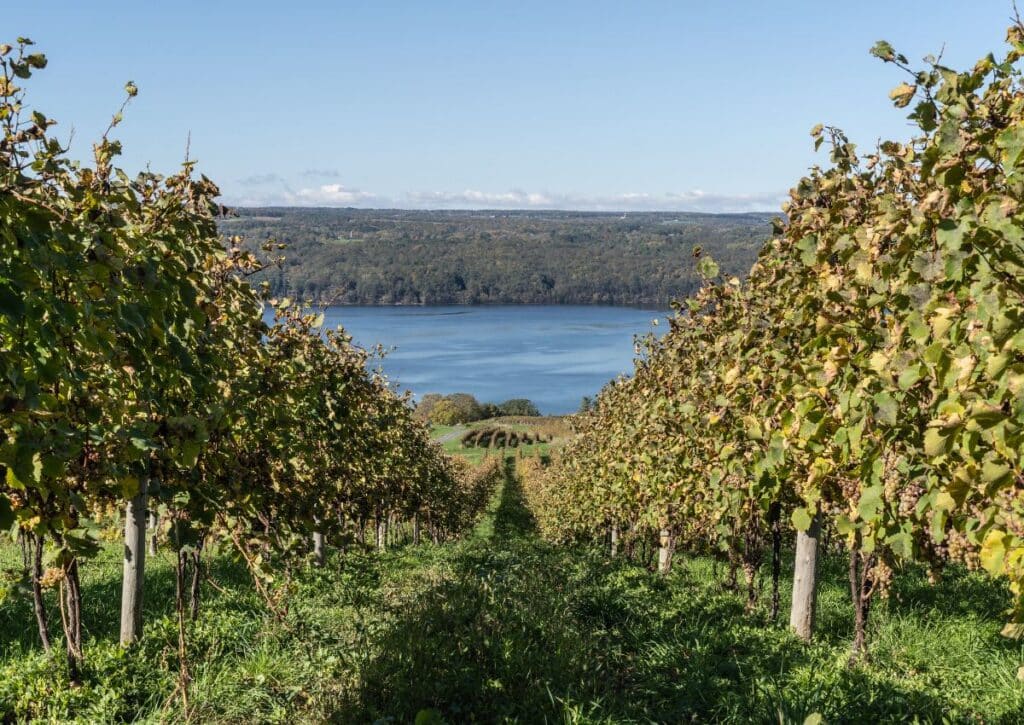
Alongside the lake trout, the yellow perch, with its vibrant striped pattern, makes frequent appearances. The waters here are also home to smallmouth bass, which dart around, creating ripples across the surface.
Cayuga Lake
Adjacent to Seneca, Cayuga Lake mirrors its beauty and rich aquatic life.
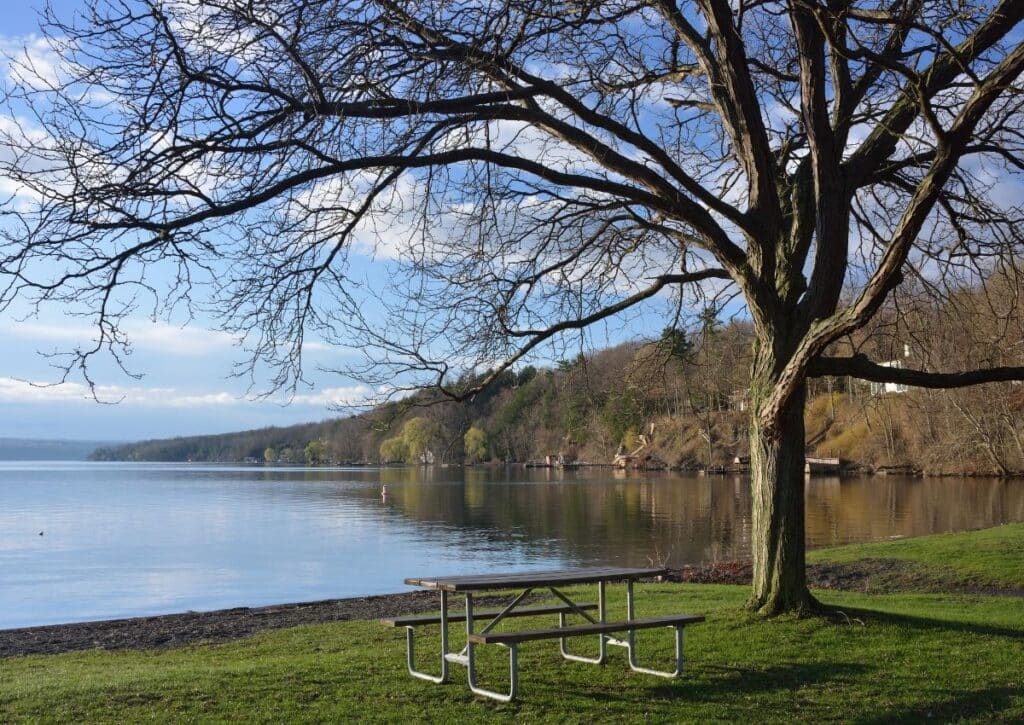
Renowned for its landlocked salmon, the lake also harbors other species such as the chain pickerel and northern pike.
On a quiet day, one might even spot the graceful walleye, its golden eye reflecting the shimmer of the water.
Potomac Ponds
Nested amidst the forest’s vast expanse, Potomac Ponds is a serene aquatic retreat. On a calm day, you can see the shimmer of sunfish as they dart through the waters.
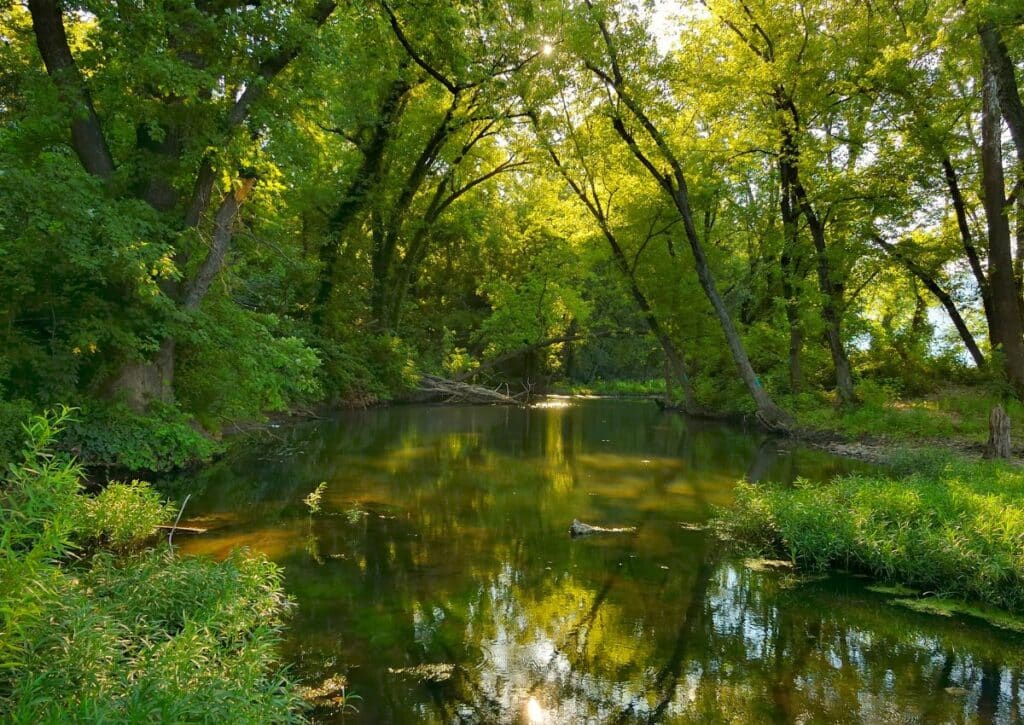
The bluegill, with its distinctive splash of color, is particularly easy to spot.
Swimming alongside them, the stealthy northern pike, a predator in these waters, lurks, always on the lookout for its next meal.
Backbone Trail Streams
The streams cascading alongside the Backbone Trail are home to a variety of smaller fish species.
The most fascinating among them is the brook trout. This native species, with its vibrant patterns, is not just a sight to behold but is also an indicator of the health of these freshwater habitats.
Interloken Trail Waters
Near the Interloken Trail, the waterbodies teem with aquatic life. The largemouth bass, a favorite among anglers, thrives here.
Their powerful leaps and splashes often break the placid water surface. Sharing their home are yellow perch, striped with golden-yellow and easily identifiable, adding their own hue to the underwater canvas.
Burnt Hill Trail Streams
The streams meandering close to the Burnt Hill Trail are a tranquil paradise for both fish and the keen observer.
The brown trout, a magnificent specimen with speckled skin, thrives here, making it an angler’s delight.
9 Best Trails in the Finger Lakes National Forest to See Wildlife
Our journey through Finger Lakes National Forest took us on a series of trails, each offering its own wildlife encounters.
These trails were more than just pathways through nature; they were corridors to unique animal tales waiting to be experienced.
Finger Lakes Gorge Trail
The Finger Lakes Gorge Trail is a prime showcase of the forest’s beauty, located close to the northern tip of Seneca Lake. Starting at Picnic Area Road, it stretches 2.3 miles round trip, suitable for both family outings and individual trekkers.
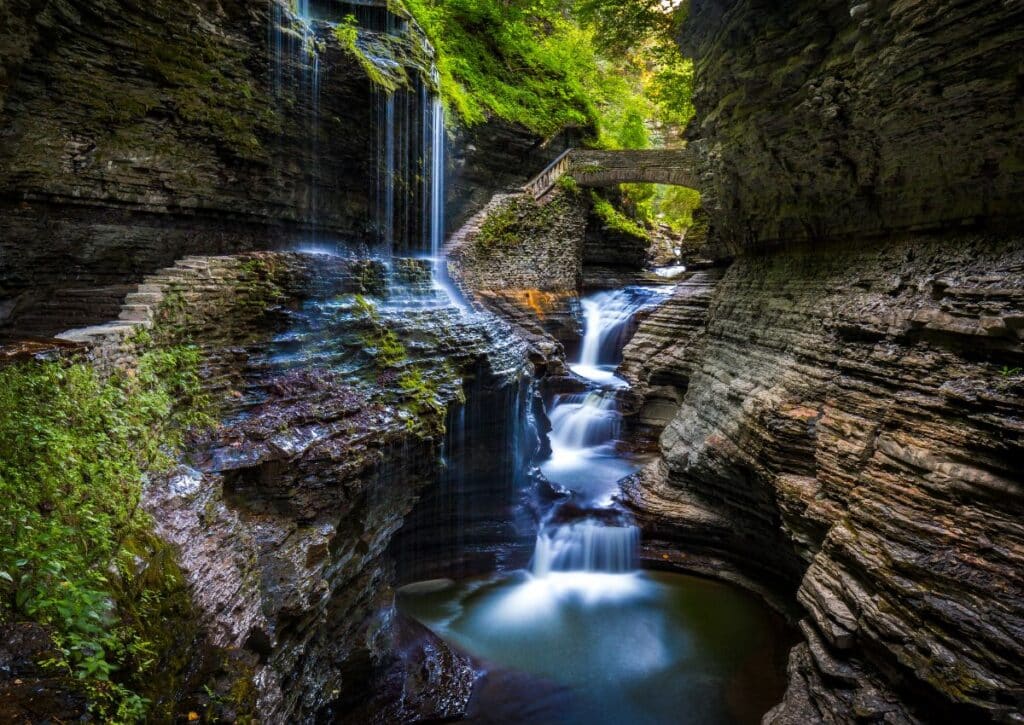
Walking this trail is like witnessing nature’s canvas firsthand. It intertwines with the gorge, revealing picturesque landscapes and the soothing sounds of cascading waters. Some rocky segments call for good footwear.
As you journey, the chorus of the forest birds – notably the Northern goshawk and scarlet tanager – adds to the ambiance.
Look closely, and you might catch a fleeting sight of aquatic life in the shimmering streams.
No-Tan-Takto Trail
The No-Tan-Takto Trail is an integral part of the Finger Lakes National Forest’s expansive trail system. Spanning 4.3 miles in total, this trail offers a balanced blend of moderate terrains, making it accessible for various skill levels.
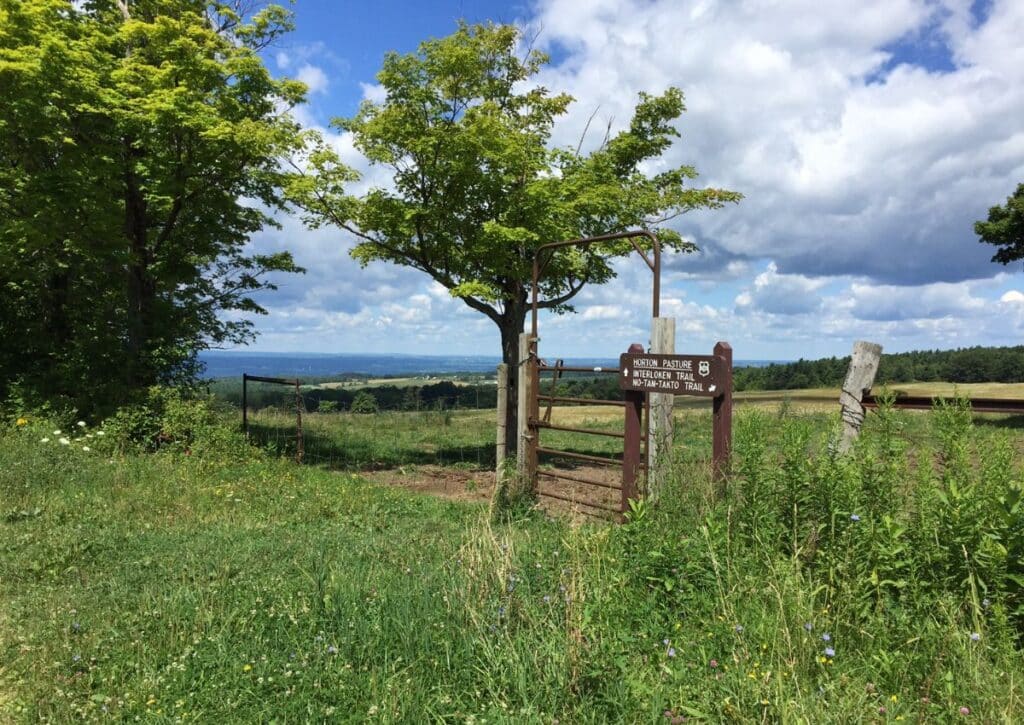
Nestled amidst the forest, the trail offers hikers the unique opportunity to traverse both woodland and open pastures.
These open areas frequently showcase free-ranging cattle, an uncommon sight in most national forests.
As you wander deeper into the woods, the chances of spotting minks and raccoons increase.
The chirrups of the yellow warbler and the Eastern towhee create a serene soundscape, adding depth to the forest ambiance.
The trail’s soil can get a tad tricky post-rain, so carrying hiking poles might give that extra edge. As you tread, occasionally look up; the expansive canopy hosts a myriad of bird species, making this trail a birder’s delight.
Ravine Loop Trail
Located in the heart of the Finger Lakes National Forest, the Ravine Loop Trail offers a diverse hiking experience.
Beginning at the Blueberry Patch Campground, this 1.75-mile trail winds through some of the most picturesque parts of the forest, drawing both seasoned hikers and novice wanderers.
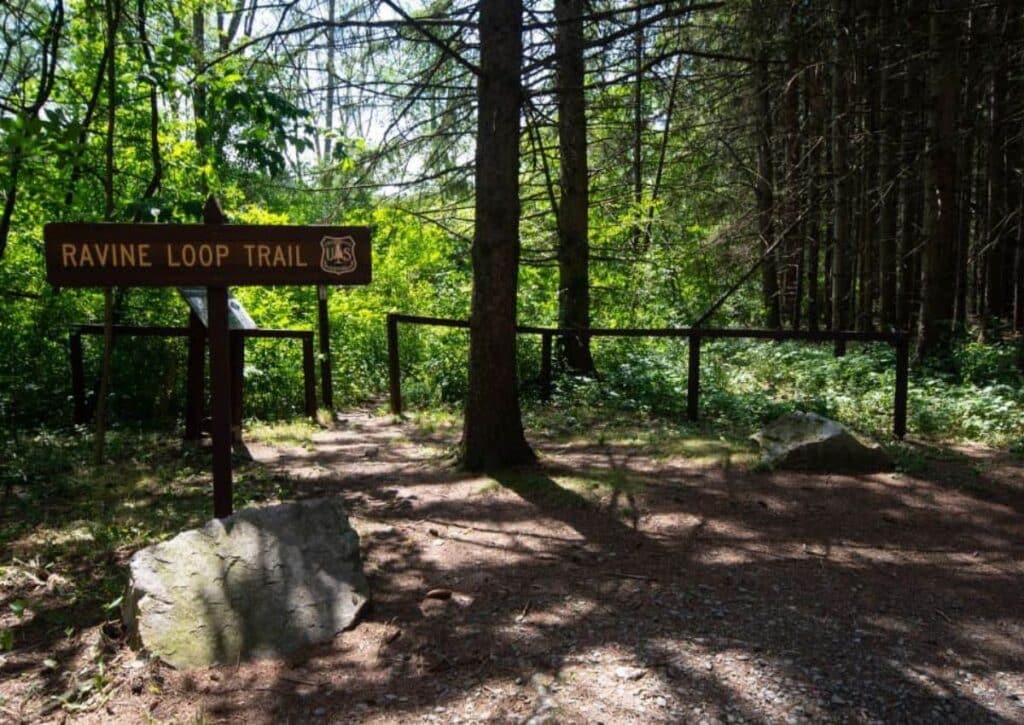
Dipping and rising through the area’s natural ravines, this moderately difficult path is a testament to the region’s geological history.
The terrain can be challenging, but the views, as you navigate through the forest’s dense patches and clearings, are rewarding.
While on the trail, the likelihood of encountering white-tailed deer silently grazing is high. And if you listen closely, the distant calls of the American kestrel or the ruffled grouse can be heard, echoing through the thick foliage.
Given the uneven terrain and some steep sections, good hiking boots are essential. And if you’re planning a trip after a heavy downpour, expect muddier paths; in such cases, hiking poles can be a boon.
Concluding at the same campground, the trail ensures you’re surrounded by nature’s best from start to finish.
Potomac Ponds Trail
Positioned towards the southern edge of Finger Lakes National Forest, Potomac Ponds Trail originates from the Potomac Group Campground. Spanning 2.5 miles, this trail is a hidden gem, suitable for both relaxed strolls and the enthusiastic explorer.
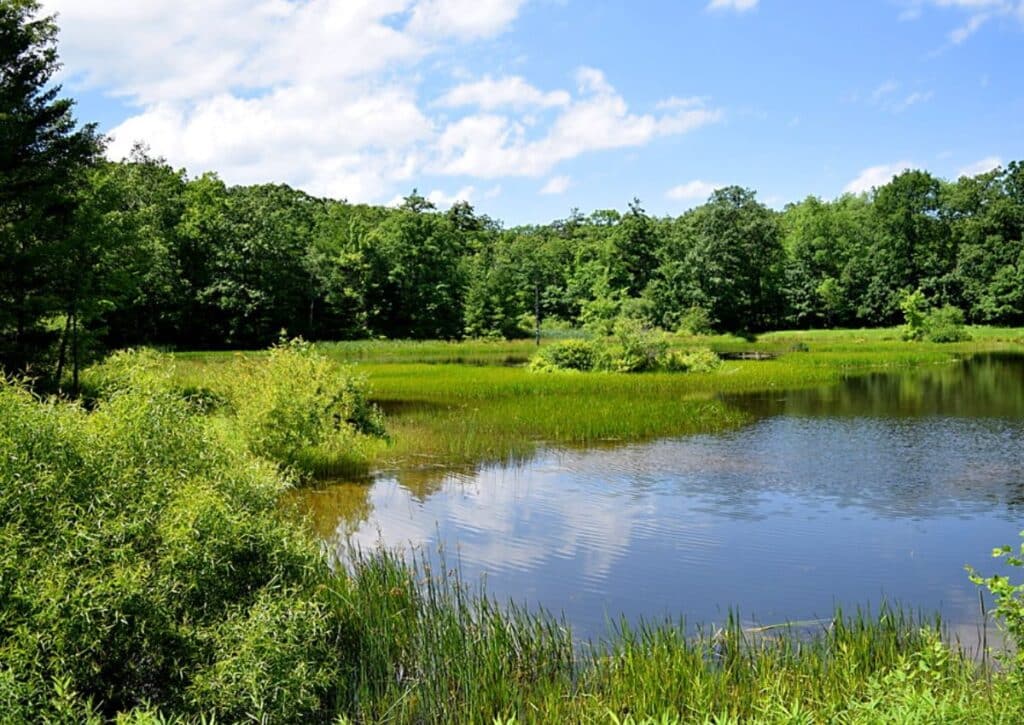
As you meander along, the serene ponds reflect the sky and surrounding greenery, occasionally disturbed by a wood duck’s takeoff or a snapping turtle’s dive.
Given its damp surroundings, a few muddy spots are to be expected, especially after a rain. Investing in decent waterproof footwear isn’t a bad idea.
Alongside, the subtle chirping of shrubland birds like the Eastern towhee amplifies the trail’s tranquil appeal.
Whether you’re a birder, a hiker, or someone seeking tranquility, Potomac Ponds offers an intimate rendezvous with nature.
Backbone Trail
Situated right at the heart of the Finger Lakes National Forest, the Backbone Trail acts as the spine of the forest trail system.
Starting from the Blueberry Patch Campground and snaking for 5.5 miles, it’s an engaging path for both novice and seasoned hikers.
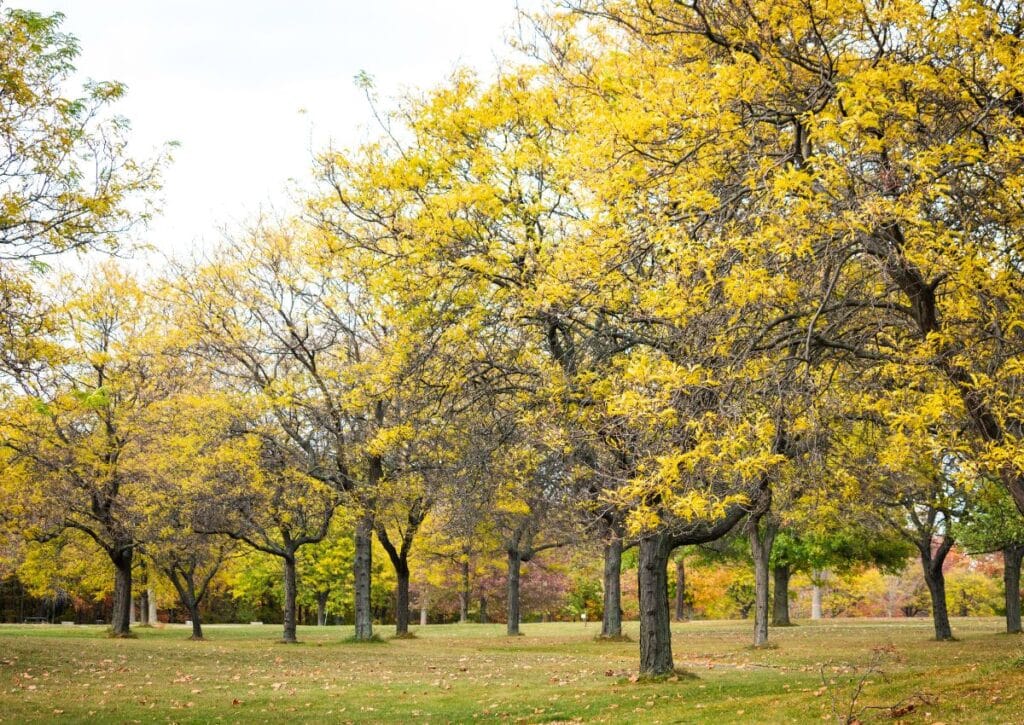
This trail does justice to its name, providing a backbone to your exploration. It traces the ridge of the forest, offering panoramic views of the lush landscape, especially during autumn when hues of orange and gold prevail.
The terrain varies, so sturdy hiking boots are advisable. As you advance, the calls of grassland birds, particularly the Henslow’s sparrow, become more audible, complementing the rhythmic rustle of leaves underfoot.
Notably, the white-tailed deer often grace visitors with their presence here. Whether you’re trekking for the vistas or the vibrant wildlife, the Backbone Trail promises a fulfilling experience.
The Finger Lakes Trail
The Finger Lakes Trail is an expansive 430-mile trek that winds through New York State, including a segment that runs through the heart of the Finger Lakes National Forest.
This stretch beautifully captures the forest’s diverse habitats, topography, and wildlife, offering an immersive experience for all who traverse it.
Situated in Schuyler County near Hector, this section of the trail provides hikers with a unique opportunity to explore the rich biodiversity of the national forest.
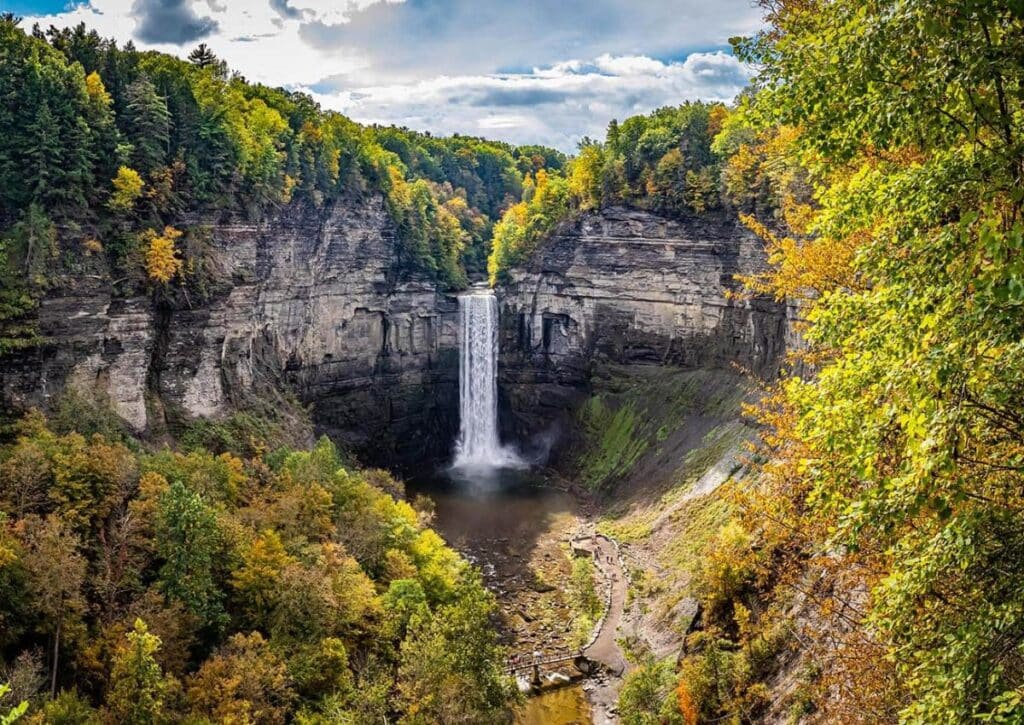
As you journey through dense woods, you might be serenaded by forest birds such as the American woodcock or catch a glimpse of elusive animals like the bobcat.
While the trail offers varying levels of difficulty, it’s consistently well-maintained and clearly marked, ensuring hikers can focus on the beauty around them.
Despite the occasional steep incline or rugged stretch, the trail is navigable for both novice and seasoned hikers.
Before embarking on your hike, it’s essential to come prepared. Sturdy footwear is a must, given the varying terrains you’ll encounter.
Additionally, carrying sufficient water, snacks, and a reliable map or GPS device can make your hike more enjoyable and safe.
The Finger Lakes Trail section within the national forest epitomizes the best of New York’s natural offerings. From its challenging terrains to its breathtaking vistas, this trail promises a memorable adventure for all who tread its path.
Interloken Trail
The Interloken Trail is a popular trek for hikers desiring a serene and immersive forest experience.
Spanning approximately 12 miles, it’s a section of the larger Finger Lakes Trail system, conveniently located between Seneca and Cayuga Lakes.
Starting near the southern tip of Seneca Lake, the trail meanders through a mosaic of habitats, revealing the diverse ecosystems that make the national forest so special.
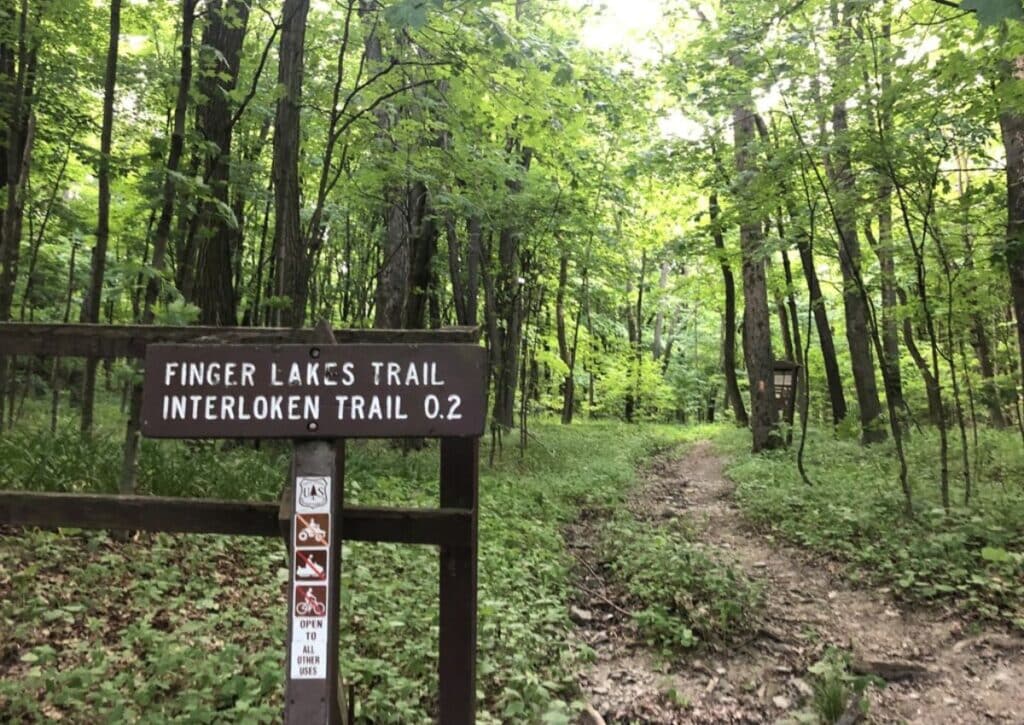
Hikers often find themselves walking amidst towering trees, only to later transition into open meadows resplendent with wildflowers.
Throughout the journey, wildlife sightings are not uncommon. The dense woodlands are a haven for animals like the white-tailed deer, while the clearings might treat you to a display of shrubland birds such as the Eastern towhee or the yellow warbler.
Given the trail’s moderate length and occasionally challenging terrains, it’s wise to don a pair of comfortable, grip-enhancing shoes.
The trail, for the most part, is well-marked, but it always pays to have a map or GPS handy to stay on course.
Tips for the Interloken Trail include starting early to make the most of your day and packing a light picnic to enjoy at one of the many scenic spots along the route.
By the end of your journey, you’ll have not just covered ground, but also woven a tapestry of experiences that encapsulate the allure of the Finger Lakes National Forest.
Burnt Hill Trail
Burnt Hill Trail, tucked in the Finger Lakes National Forest, is a trail less frequented, offering hikers an intimate encounter with nature’s untouched beauty.
This trail stretches for roughly 4.3 miles and is located close to the southeastern region of Seneca Lake.

The initial part of Burnt Hill takes you through dense woodlands, where the canopy overhead forms a tranquil, dappled shade. The forest here is a sanctuary for animals such as the elusive bobcat and the playful raccoon.
Bird enthusiasts can expect sightings of forest birds, including the ruffed grouse and the American woodcock.
As the trail progresses, the woodlands give way to serene meadows. During spring and early summer, these meadows are a riot of color, adorned with wildflowers that sway gently to the rhythm of the breeze.
The trail itself is of moderate difficulty, making it accessible to most hikers. However, due to its occasionally uneven terrain, sturdy footwear is recommended.
An early start, especially during summer months, can help avoid the afternoon sun and provide cooler hiking conditions.
For those who embark on the Burnt Hill Trail, the journey is more than just physical; it’s a refreshing mental and spiritual cleanse amid nature’s pristine offerings.
Pack a light snack, and perhaps you’ll find the perfect spot overlooking the forest to pause, reflect, and rejuvenate.
Blueberry Patch Campground via the Interloken Trail
A delightful segment of the Finger Lakes National Forest is the journey from the Interloken Trail to the Blueberry Patch Campground.
This trek, starting near the heart of the forest, is just over 6 miles, perfect for those looking to immerse themselves in a day’s exploration.
Initiating your hike on the Interloken Trail, you’re immediately enveloped by lush woodlands. These green canopies are a haven for shrubland birds like the yellow warbler and the Eastern towhee, their melodies accompanying your steps.
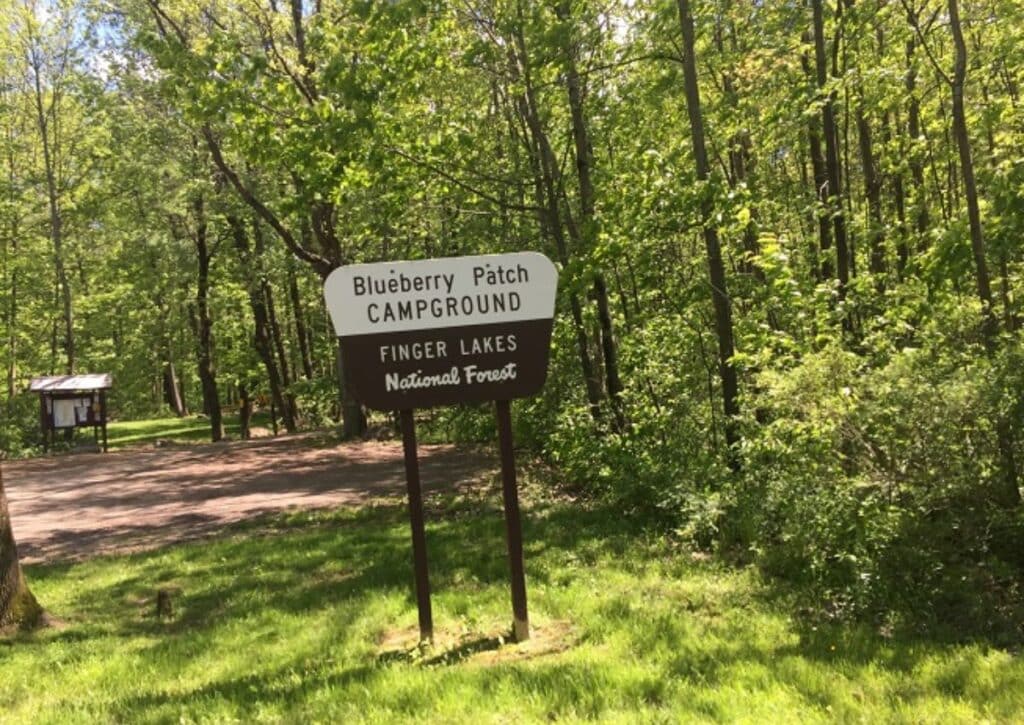
The rustling leaves might even reveal a mink or a porcupine making their way through the underbrush.
As the trail stretches on, anticipate a diverse topography. The soft forest floor, occasionally intersected by bubbling streams, offers a refreshing setting for reflection.
While it’s moderately challenging, there are serene pockets perfect for breaks; by a brook or an opening with panoramic views of the forest.
Reaching the Blueberry Patch Campground is its own reward. Nestled in a serene clearing, it’s named aptly for the wild blueberry bushes that populate the area.
Come summer, these bushes are laden with juicy berries, a treat for both campers and wildlife, including the raccoon.
A few tips for hikers: wear shoes that can handle both forest terrain and occasional wet patches, especially after rains. Also, if visiting during berry season, a small container might be handy for some blueberry picking.
And always remember, while the blueberries are a delightful treat, be sure to save some for the next traveler and the forest’s inhabitants.
Ending your day at the Blueberry Patch Campground, whether you decide to set up a tent or just rest before heading back, the tranquil surroundings and the evening chorus of the forest birds make for a perfect wilderness experience.
Making the Most of Your Wildlife Experience
The Finger Lakes National Forest is a treasure trove of wildlife experiences. From the gentle grazers to the elusive predators, and the chirping birds to the darting fish, every creature here contributes to the tapestry of life in the forest.
For the enthusiastic wildlife observer, knowing when, where, and how to watch can turn a simple hike into an unforgettable adventure.
Wildlife Watching Tips in Finger Lakes National Forest
- Start Early, Stay Late: Dawn and dusk are the magic hours. Many animals are most active during these times. Plus, the softer light can offer a photographer’s dream.
- Be Quiet and Patient: Noise can scare animals away. Move quietly, speak in hushed tones, and consider sitting quietly in one good spot.
- Use Binoculars: A good pair of binoculars lets you observe animals without getting too close and disturbing them.
- Follow Animal Signs: Look for tracks, droppings, and feeding areas. They can give clues to where animals might be.
- Dress in Camouflage or Neutral Colors: Bright colors can be easily spotted by animals and scare them away.
Best Times and Places to Spot Wildlife
- Spring: A burst of activity can be seen as animals emerge from hibernation and birds begin migrating. The Backbone and Interloken trails are particularly active during this time.
- Summer: Early mornings near water sources, like Seneca and Cayuga Lakes, are perfect for spotting thirsty animals. Birds flourish in the ravines and gorges.
- Autumn: As leaves fall, visibility improves. Deer are more active due to the rutting season. The No-Tan-Takto and Ravine Loop trails provide excellent viewing opportunities.
- Winter: Animal tracks in the snow can lead to exciting discoveries. Bobcats and foxes might be seen patrolling for food.
Keeping Wildlife Wild: Do’s and Don’ts
- Do Not Feed Wild Animals: It’s harmful to them and can lead to aggressive behavior.
- Keep a Safe Distance: Approaching too closely can be stressful or even dangerous.
- Store Food Securely: At campgrounds or picnic areas, ensure food is stored away, making it inaccessible to wildlife.
- Avoid Wildlife During Sensitive Times: Nesting birds, mating seasons, and mothers with young should be given extra space and respect.
- Follow Leave No Trace Principles: Always pack out what you pack in, and avoid leaving any trash or food scraps behind.
Remember, the Finger Lakes National Forest is home to these creatures. By observing responsibly, you not only safeguard them but also ensure that they continue to thrive for generations to come.
A Brief Overview of the Finger Lakes National Forest
Located on the backbone ridge between Seneca and Cayuga Lakes in the famed Finger Lakes region lies the Finger Lakes National Forest.
Unique to New York State, it stands as its only national forest, echoing the vast open lands and free-ranging cattle commonly seen in western national forests.
Covering an expanse of 16,032 acres, it’s more than just a forest—it’s a testament to nature’s untouched splendor, reminiscent of both the wild beauty of the west and the distinct charm of the east.
Nestled in Hector, Schuyler County, this verdant escape offers over 30 miles of interconnecting trails.
These pathways meander through deep gorges, serene ravines, open pastures, and dense woodlands.
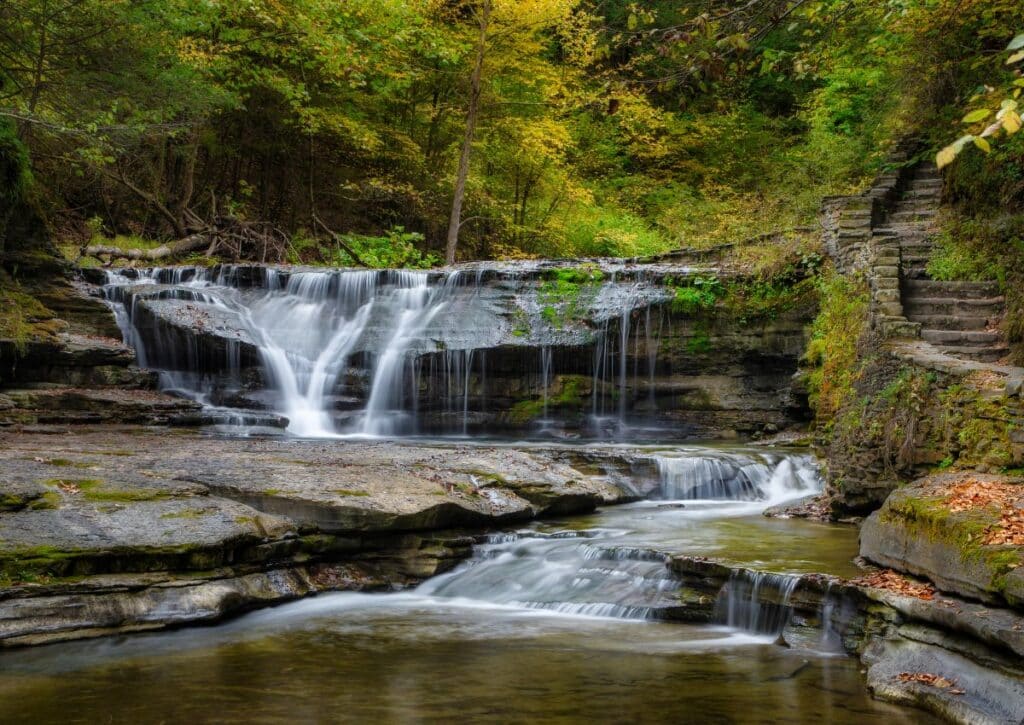
Managed with the goal of nurturing diverse ecosystems, the forest presents a rich tapestry of shrublands, grasslands, and forestlands, including areas that house ancient trees and offer diverse habitats for wildlife.
Best Times to Visit and What to Expect
Late spring to early fall remains an ideal time to experience the forest’s full bloom. The melodies of birds and the gentle rustlings of deer in the distance mark the soundtrack of the forest.
And if a snowy retreat appeals to you, winter paints a serene landscape perfect for cross-country skiing.
Nearby Towns
The forest’s allure is amplified by the neighboring towns, like Watkins Glen with its cascading waterfalls and racing legacy.
A trip to Burdett offers intimate encounters with local wineries and charming eateries.
Here, it’s not just about the trails, but also the rich culture and warmth of local hospitality.
Amenities for Visitors and Hikers
Geared to cater to both day visitors and weekend adventurers, the Finger Lakes National Forest is rich in amenities.
Camping enthusiasts will find welcoming grounds, while day visitors can opt for numerous picnic spots. Trails cater to all, from beginners to seasoned hikers.
For those keen on wildlife, like us, strategically placed viewing areas ensure memorable sightings without disturbing the natural balance.
Given its proximity to cities like Rochester, Syracuse, and Binghamton, all within a two-hour drive, the forest beckons as a convenient yet otherworldly escape.
Final Thoughts
The Finger Lakes National Forest isn’t just a destination; it’s an experience. From the diverse trails winding through its heart to the spectrum of wildlife that calls it home, every visit promises a new story to discover.
As we retraced our steps through the forest, from beaver sightings at Potomac Ponds to the whisper of the Northern goshawk overhead, it’s evident that the forest is more than its verdant stretches.
It’s a testament to nature’s unyielding charm and the symbiotic relationship we share with our wild neighbors.
For those planning a visit, take a moment to pause, listen, and observe. Beyond the scenic beauty and the thrill of the trails, there lies a world alive with wonders waiting to be explored. Every chirp, rustle, and splash has a tale to tell.
And as you tread, remember that we are mere visitors in this natural realm, and our respect and care ensure it remains pristine for others to cherish.
The Finger Lakes National Forest stands as a gentle reminder of the simple pleasures of life – the joy of a hike, the serenity of a sunset, and the magic of wildlife in their natural habitat.
As the saying goes, “In every walk with nature, one receives far more than he seeks.” And in the Finger Lakes, this couldn’t be more true.

